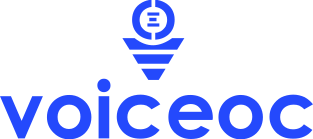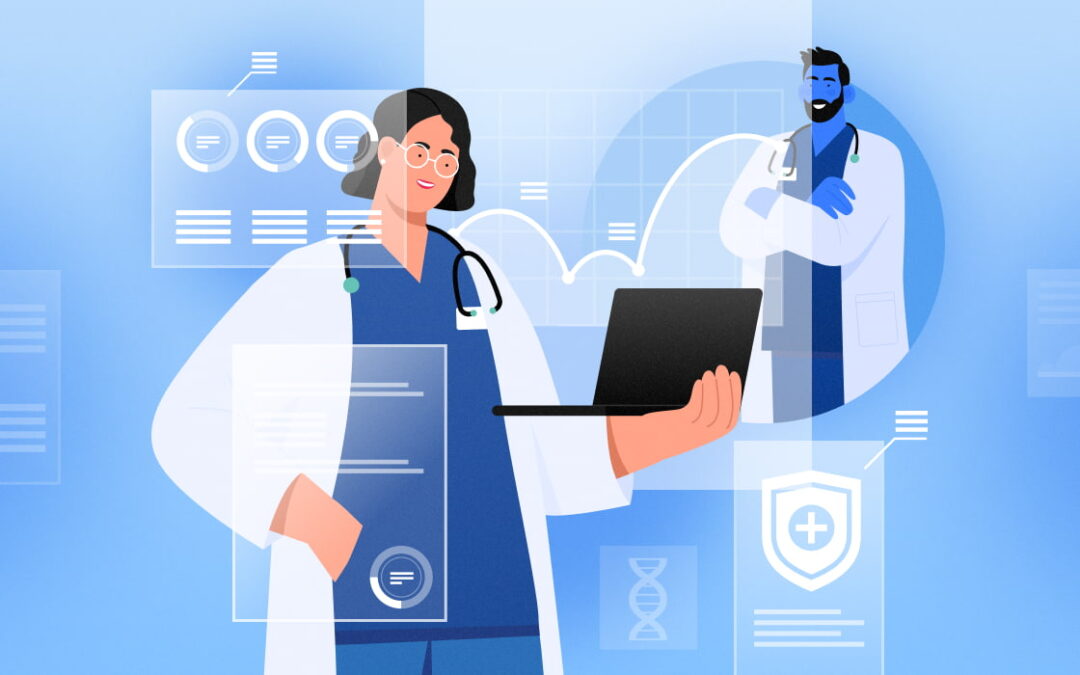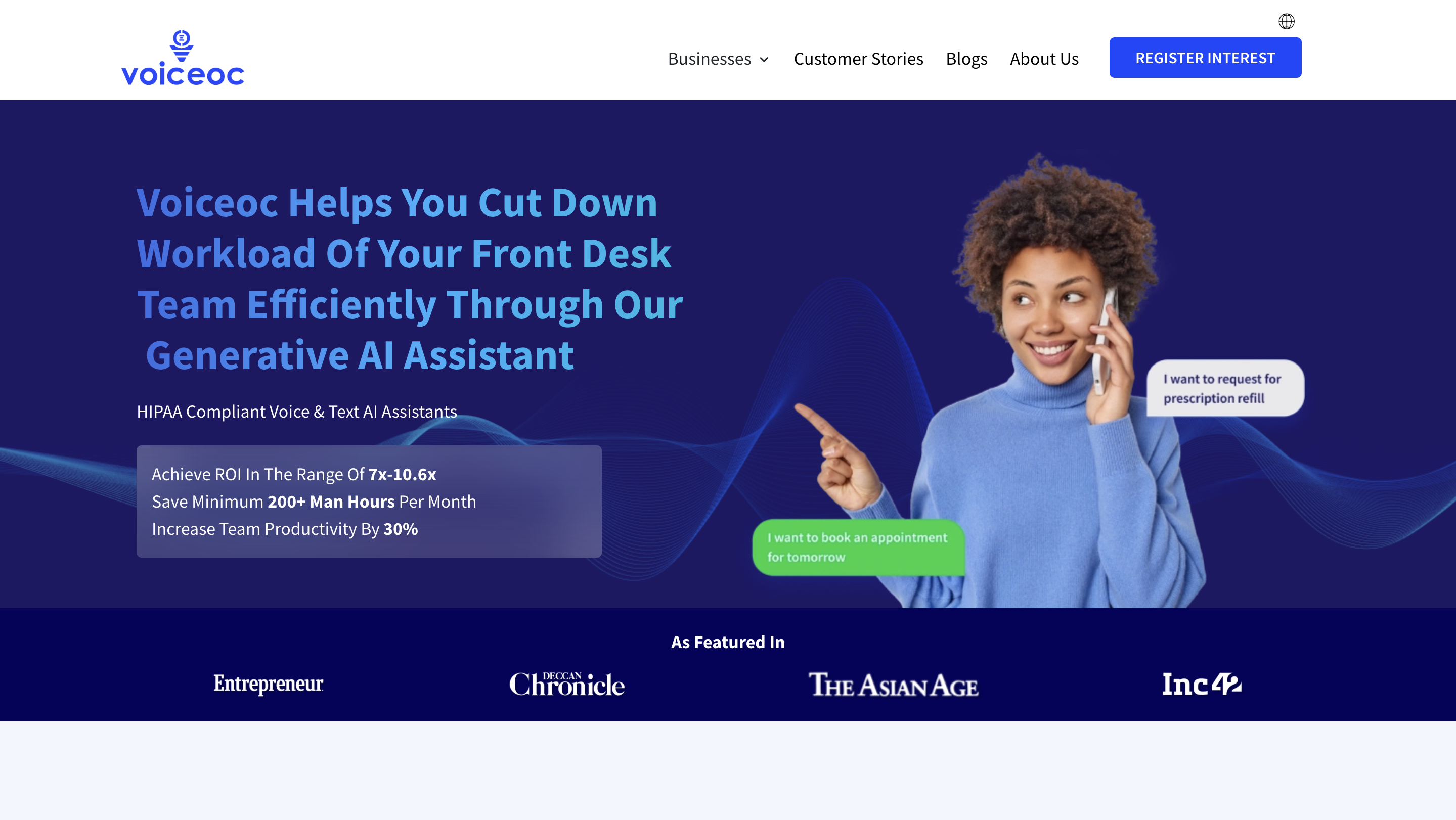How Can Automation in Healthcare Be a Game Changer in The Future of Patient Care
Voice automation in the healthcare industry is rapidly transforming the landscape of medical
practices, offering unprecedented efficiency and accuracy. As we delve into the realm of medical
speech recognition (MSR), it’s essential to grasp its fundamental principles and profound
implications for healthcare delivery.
What is Medical Speech Recognition?
At its core, Medical Speech Recognition (MSR) is a revolutionary technology that enables
seamless conversion of spoken words into text.
Imagine speaking your thoughts, and instantaneously witnessing them materialize on your
screen – that’s the power of MSR. This sophisticated tool transcends traditional typing methods,
offering healthcare professionals a hands-free and intuitive means of documenting patient
encounters.
The Role of Speech Recognition in Healthcare
In the fast-paced environment of healthcare, time is of the essence, and accuracy is paramount.
Here’s where speech recognition emerges as a game-changer, streamlining tedious
documentation processes and empowering practitioners to focus more on patient care.
By harnessing the capabilities of MSR, these healthcare organizations and providers can
efficiently capture medical notes, update electronic health records (EHRs), and communicate
critical information with ease.
Voice recognition technology has revolutionised healthcare by streamlining various processes,
including patient data entry and electronic health records (EHRs).
With these voice recognition capabilities, healthcare providers can efficiently dictate medical
notes directly into EHR systems, eliminating the need for manual data entry and allowing them
to focus more on patient care. This not only enhances the accuracy and timeliness of patient
records but also improves overall workflow efficiency.
How Speech Recognition Revolutionises Healthcare
Speech recognition software plays a crucial role in optimising dictation processes for radiology
and diagnostic reports. Radiologists and other specialists can dictate their findings directly into
the system, significantly reducing the time required for transcription.
This leads to faster turnaround times for reports and enhances the accuracy of medical
documentation, ultimately improving patient care and treatment outcomes.
Architecture of Speech Recognition Systems
At the core of speech recognition systems lies a sophisticated architecture designed to
seamlessly convert spoken words into actionable data.
An automatic speech recognition (ASR) engine serves as the backbone, swiftly transforming
voice inputs into textual format.
Subsequently, a natural language processing (NLP) module comes into play, enhancing the
interpretability of voice data through advanced algorithms and techniques.
1. Semantic Analysis
Semantic analysis within the NLP module ensures that the transcribed text maintains context
coherence, adjusting ASR-generated content to align with the surrounding information
exchange dialogue. This crucial step enables the creation of cohesive and contextually relevant
documentation.
2. Named Entity Recognition (NER)
Employing cutting-edge NER technology, the system identifies specific entities within the
transcribed text, such as patient details, medical conditions, or healthcare providers.
By cross-referencing against extensive knowledge bases like the Unified Medical Language
System (UMLS), the NER component enriches the text with pertinent information, facilitating
accurate electronic health record generation.
3. Intention Detection
Intention detection capabilities enable the system to discern voice commands embedded within
the dialogue, swiftly executing actions based on the user’s verbal instructions.
Whether scheduling appointments, retrieving medical records, or initiating diagnostic
procedures, these voice search commands streamline workflow operations with unparalleled
efficiency.
Also Read: Leveraging AI In Healthcare Sector
Key Features of Speech Recognition Technology
Healthcare providers can enhance patient communication and engagement through virtual
health assistants powered by natural language processing and voice recognition technology.
These assistants can interact with patients, provide personalised health information, and assist
medical staff with appointment scheduling and medication reminders.
By facilitating seamless communication between patients and healthcare providers, virtual
health assistants contribute to improved patient satisfaction and adherence to treatment plans.
1. Dictation
With seamless dictation capabilities, patients and clinicians can effortlessly articulate notes and
observations, leveraging the software’s prowess to transcribe spoken words into textual records
accurately.
2. Automated Appointment Summaries Generation
Harnessing the power of natural language processing, speech recognition software
autonomously sifts through transcribed content, distilling relevant medical information to
generate comprehensive appointment summaries.
This feature streamlines administrative tasks, allowing practitioners to focus more on patient
care.
3. Voice-Enabled Commands
Voice-enabled commands offer a hands-free approach to software interaction, enabling users to
navigate through functionalities effortlessly. Whether scheduling appointments, creating
treatment plans, or accessing medical records, voice commands enhance user experience and
operational efficiency.
4. Voice Patterns Recognition
Through continuous machine learning and algorithms, AI-based speech recognition software
adapts to users’ unique voice patterns, ensuring accurate transcription and documentation.
This personalised approach enhances accuracy and minimises errors, optimising workflow
productivity.
5. Data Encryption
Medical transcription services benefit greatly from voice recognition technology, enabling
efficient conversion of voice-recorded medical reports into text format
This is particularly valuable for specialties such as radiology, where accurate and timely clinical
documentation of findings is critical for patient care. Voice recognition reduces transcription
time and errors, allowing healthcare professionals to focus more on delivering quality patient
care.
Also Read: How to Boost Patient Engagement Using Conversational Al
Voice Recognition and Artificial Intelligence in Healthcare
In today’s dynamic healthcare landscape, the integration of voice recognition and artificial
intelligence (AI) technologies is revolutionizing patient care delivery, both at the bedside and in
at-home settings. Let’s delve into how these innovations are reshaping the healthcare
experience.
Enhancing Bedside and At-Home Care with Voice Recognition and AI
The fusion of voice and speech recognition solutions and AI technologies holds immense
potential in streamlining various healthcare processes, ensuring efficiency and improving patient
outcomes. Consider the following scenarios:
1. Voice-Activated Patient Room Controls: Remote patient monitoring solutions leverage
voice recognition technology to enable patients to report symptoms and provide updates on
their condition easily.
By using voice-enabled tools for data collection, patients can communicate vital information to
healthcare providers in real-time, facilitating proactive interventions and personalized care
plans.
This enhances patient engagement and enables timely adjustments to treatment strategies,
ultimately improving healthcare outcomes.
2. Clinical Decision Support: AI-powered voice recognition systems can assist clinicians by
providing real-time access to critical patient information and treatment protocols.
Whether it’s retrieving a patient’s voice and vitals or calculating medication dosages, these tools
empower providers to make informed decisions promptly.
3. Patient Education and Engagement: Voice-enabled AI devices can guide patients through
self-care routines and medication management, enhancing their understanding of treatment
plans and promoting adherence.
Moreover, interactive voice assistants can address patients’ inquiries, fostering a sense of
empowerment and trust in their care journey
Exploring the Synergy between Voice Recognition and AI
Technologies
The marriage of these voice recognition technologies and AI extends beyond the clinical setting,
offering innovative solutions for remote patient monitoring and chronic disease management:
1. Remote Monitoring: AI-driven voice recognition technology enables remote monitoring of
patients’ health status, allowing healthcare teams to intervene proactively in case of any
anomalies.
From tracking vital signs to assessing symptoms, these systems provide valuable insights into
patients’ well-being, leading to early intervention and prevention of complications.
2. Chronic Disease Management: Voice-enabled AI applications facilitate personalized care
plans tailored to individual patient needs. By analyzing voice data and patient-reported
symptoms, these solutions can detect patterns indicative of disease exacerbation or treatment
non-compliance, prompting timely interventions and adjustments to care plans.
3. Caregiver Support: Voice recognition and AI technologies alleviate the burden on caregivers
by automating routine tasks and providing assistance in caregiving activities.
Whether it’s reminding patients to take medications or guiding caregivers through medical
procedures, these tools enhance the quality of care while reducing caregiver stress and fatigue.
Also Read: Self-Patient Service in Healthcare: Benefits & Tips
Benefits of Voice Recognition Software in Healthcare
Voice automation in healthcare offers a myriad of advantages, revolutionising various aspects of
medical practice:
1. Enhanced Efficiency through Automated Documentation
Healthcare providers experience significant time savings by leveraging their voice recognition
devices and software for administrative tasks like data entry and documentation. Studies, such
as one published in the Journal of the American Medical Informatics Association, indicate that
over 80% of medical professionals witness improved workflows post-implementation of speech
recognition technology.
2. Elevating Patient Experience with Seamless Interaction
By reducing the time spent on administrative duties, healthcare professionals can focus more on
delivering personalised care to patients. Voice-activated virtual assistants contribute to this by offering tailored support and relevant information, thereby enhancing patient engagement and satisfaction.
3. Error Reduction in Medical Documentation Processes
Continuous advancements in voice recognition technology ensure enhanced accuracy in the medical documentation process, minimising the occurrence of errors. Accurate records are pivotal for developing effective treatment plans and mitigating potential legal ramifications.
4. Hands-Free Operation for Healthcare Providers
In settings such as operating rooms and laboratories, where manual data entry is impractical or unhygienic, voice recognition software facilitates hands-free operation.
This not only enhances convenience but also helps maintain a sterile environment, promoting patient safety.
5. Cost Savings and Resource Optimisation
Despite the initial investment required for implementation, the efficiency gains achieved through speech recognition software translate into substantial cost savings in the long term.
Additionally, the reduction in documentation errors can lead to savings associated with corrections and legal expenses.
The amalgamation of these applications and benefits underscores the transformative potential of speech recognition software in the healthcare domain. This technology is reshaping healthcare delivery by streamlining operations, fostering patient engagement, and ensuring the accuracy of medical documentation.
Key Applications of Voice Recognition in Healthcare
As technology continues to evolve, voice automation is revolutionising various aspects of healthcare delivery. Let’s delve into some key applications where voice and speech recognition solution and technology is making a significant impact:
1. Streamlining Patient Data Entry and Electronic Health Records (EHRs)
Traditionally, healthcare providers have grappled with the cumbersome task of manual data entry complete medical note into electronic health records (EHRs). This process not only consumes valuable time but also detracts from direct patient care.
Voice recognition software offers a solution by allowing providers to dictate medical notes directly into the EHR system. By eliminating the need for manual typing, this technology streamlines the documentation process, ensuring more accurate and up-to-date patient records.
2. Optimising Dictation Processes for Radiology and Diagnostic Reports
Radiologists and other diagnostic specialists often face the challenge of analysing intricate medical images and documenting their findings comprehensively.
Speech recognition software significantly enhances dictation processes by enabling these professionals to verbalise their reports. This results in expedited turnaround times and reduces the likelihood of errors in documentation, ultimately leading to more efficient patient care.
Enhancing Patient Communication through Virtual Health Assistants
Virtual health assistants, powered by voice recognition technology, are transforming patient communication and engagement. These assistants serve as invaluable resources, reminding patients to take medications, schedule appointments, and access relevant health information.
By facilitating seamless communication between patients and healthcare providers, virtual assistants contribute to improved patient satisfaction and overall healthcare outcomes.
3. Facilitating Medical Transcription Services
Medical transcription plays a crucial role in converting voice-recorded medical reports into written format. Voice recognition software revolutionises this process by drastically reducing transcription time and enhancing the accuracy of transcribed documents.
This is particularly beneficial for specialists such as radiologists and pathologists who heavily rely on medical imaging and require efficient documentation of their findings.
4. Enabling Remote Patient Monitoring Solutions
Remote patient monitoring is vital for effective chronic disease management and timely intervention. Voice recognition software simplifies this process by allowing patients to easily report symptoms and provide updates on their health status without the need for complex inputs.
Healthcare providers can receive real-time information, enabling them to intervene promptly when necessary and improve patient outcomes.
Revolutionising Healthcare Engagement with Voiceoc
Voice recognition and speech recognition technologies have ushered in a new era of healthcare engagement.
Voiceoc, the smartest voice recognition system tailored exclusively for the healthcare sector, leverages these advancements to empower healthcare providers in delivering exceptional patient care.
By seamlessly managing engagement touch points and offering valuable insights through patient conversations, Voiceoc revolutionizes healthcare delivery.
Features of Voiceoc
1. Simplified Patient Communication
Voiceoc simplifies patient communication by enabling voice recognition technology to send ‘Voice Messages.’ Patients can convey their concerns effortlessly, enhancing convenience and engagement. This feature streamlines interactions, allowing patients to communicate more naturally.
2. Enhanced Productivity of Customer Care Agents
Voiceoc’s AI Agent assist module intelligently interprets patient expectations and seamlessly transfers chats to customer care agents when necessary.
Equipped with a proprietary mapping algorithm, this module ensures swift and efficient routing of patients to the most suitable agents, enabling them to track productivity and provide prompt support.
3. Informed Decision-Making Through Data Insights
Voiceoc empowers healthcare industry with deeper insights into patient engagement and
behaviour, leveraging speech recognition technology.
By analysing patient conversation data, organizations can identify areas for improvement, optimize bookings, and outperform competitors. This data-driven approach enables informed decision-making and enhances operational efficiency.
4. Seamless Integration with Existing Systems
Voiceoc seamlessly integrates with existing Health Information Systems (HIS), Laboratory Information Systems (LIS), and third-party applications.
With robust security measures in place, Voiceoc ensures seamless interoperability and data exchange, leveraging electronic health records to enhance patient care.
5. Real-Time Monitoring of Patient Emotions
Voiceoc’s AI Sentiment Analysis engine monitors patient emotions in real-time, leveraging natural language processing.
By proactively addressing patient dissatisfaction, Voiceoc helps convert unhappy patients into satisfied advocates of healthcare services, enhancing patient satisfaction and loyalty.
Voiceoc represents a paradigm shift in healthcare engagement, offering unparalleled efficiency, insights, and patient satisfaction through the synergy of voice recognition and speech recognition technologies.
Conclusion
Speech Recognition technology, including voice- implement speech recognition, and speech recognition technologies, offers a wide range of applications that enhance efficiency, accuracy, and patient satisfaction across various aspects of healthcare delivery.
From streamlining documentation processes to improving patient communication and enabling remote monitoring, voice automation plays a pivotal role in transforming the healthcare landscape for the better.
It’s encouraging to see the positive impact that voice recognition technology is already having on healthcare.
By leveraging voice-enabled tools like Voiceoc and virtual health assistants, patients can access information and support more easily, while healthcare providers can focus on delivering high-quality care.
As these technologies continue to mature, the possibilities for improving healthcare outcomes are limitless.
In the dynamic landscape of healthcare, where patient satisfaction and operational efficiency are paramount, Voiceoc emerges as a game-changer.
By harnessing the power of voice recognition and speech recognition technology, Voiceoc revolutionises patient communication and engagement. With its seamless integration with existing systems and real-time monitoring capabilities, Voiceoc not only streamlines workflows but also enhances patient satisfaction.


